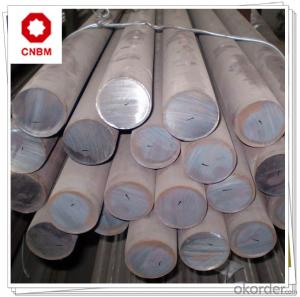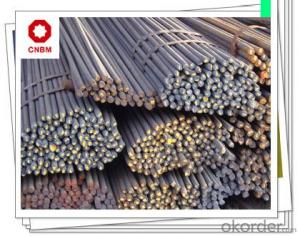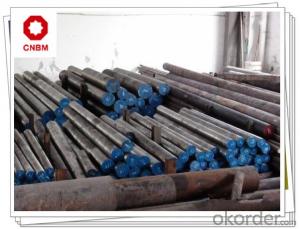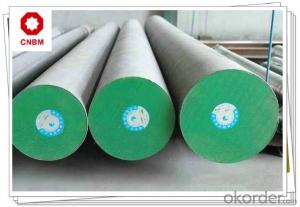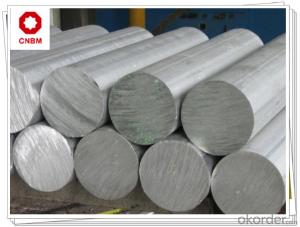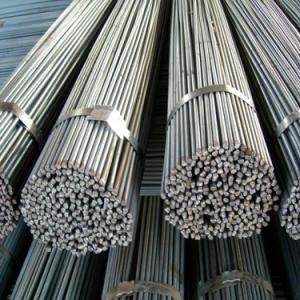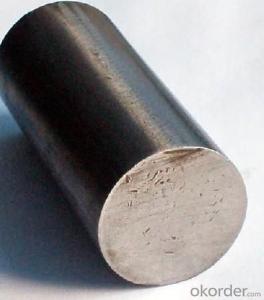Carbon Structural Steel Round Bars ST37-2CR
- Loading Port:
- Shanghai
- Payment Terms:
- TT OR LC
- Min Order Qty:
- 25 m.t.
- Supply Capability:
- 120000 m.t./month
OKorder Service Pledge
OKorder Financial Service
You Might Also Like
Carbon Structural Steel Round Bars ST37-2CR
Product Specification
1, Chemical Composition %
| Grade | C | Si | Mn | S | P | Cr |
| ST37-2CR | 0.21-0.25 | ≤0.35 | ≤1.4 | ≤0.045 | ≤0.045 | ≥0.30 |
2, Mechanical Properties
| Strength of Extension σb | Yield Strength σs | Impact AKv |
| 340-470 Mpa | ≥235 Mpa | ≥27J |
3, Diameter: 9mm - 80mm
Application
1, Widely used in construction and engineering structure.
2, Widely used in making reinforcing steel bar or building plant room rack, high voltage transmission tower, bridge, vehicle, boiler, vessel, ship, etc.
3, Widely used in manufacturing mechanical parts which are not required to be with high performance.
Product Main Points
1, Heat Treatment: normalizing, annealing, tempering, quenching
2, Surface Treatment: black, grinding, bright, polish
3, Product Process: hot rolled, cold drawn, forged
FAQ
1, Payment Terms:
30% T/T deposit & 70% T/T before delivery.
Irrevocable L/C at sight
2, Trade Terms:
EXW, FOB, CIF, CNF
3, Delivery Time:
Normally 30-40 days. According to quantity.
4, Manufacture or Trading Company:
CNBM is a state-owned fortune global 500 trading company. We have intergrated supply system.
There are about 20 overseas locations in different countries.
Product Show
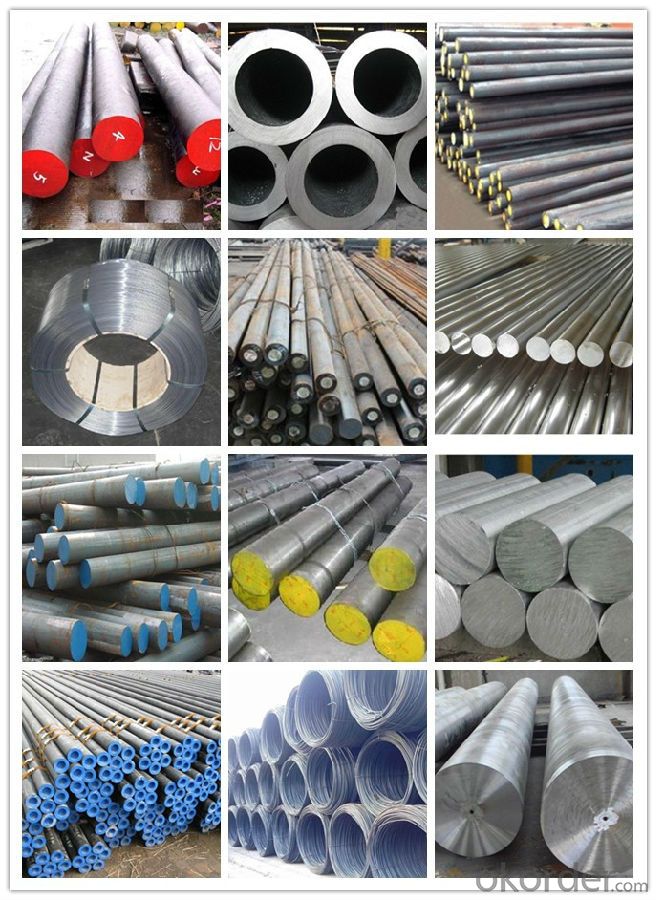
Work Shop
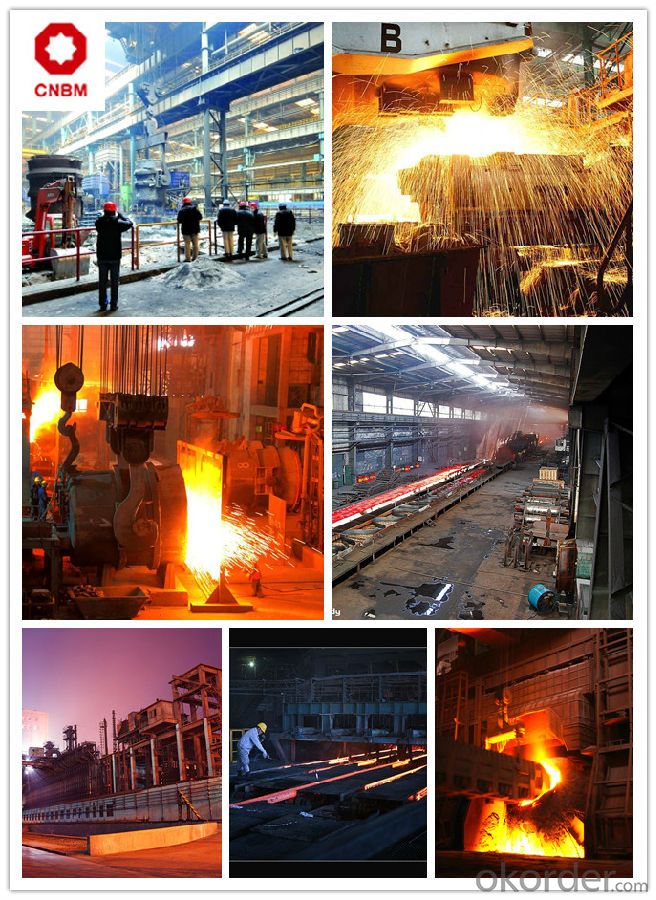
About Us

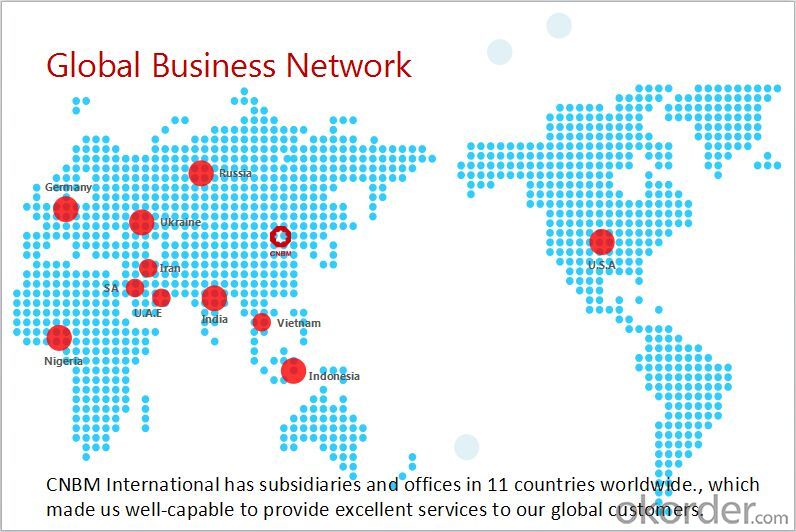
- Q:What is the difference between a solid round bar and a hollow round bar?
- A cylindrical shape, known as a solid round bar, consists of a single material, typically metal or plastic. It maintains a consistent diameter throughout its length, without any empty space inside. In contrast, a hollow round bar also has a cylindrical shape but contains a hollow space within its center. This hollow space creates a tube-like structure within the bar. The outer diameter remains constant, but the inner diameter varies depending on the design and purpose of the hollow round bar. The primary distinction between a solid round bar and a hollow round bar lies in their structural characteristics and potential uses. The solid round bar offers strength and rigidity due to its solid core, making it suitable for applications requiring robust support or load-bearing capabilities. It finds common usage in construction, manufacturing, and engineering projects where strength and durability are vital. Conversely, the hollow round bar combines strength with a lightweight design. The presence of the hollow space reduces the overall weight while maintaining structural integrity. This makes hollow round bars ideal for applications prioritizing weight reduction, such as in the aerospace, automotive, and marine industries. Furthermore, the hollow space can serve various purposes, such as facilitating the passage of fluids, wires, or other components through the bar. In conclusion, while both solid and hollow round bars possess a cylindrical shape, the presence or absence of a hollow space distinguishes them. Solid round bars offer strength and rigidity, while hollow round bars strike a balance between strength and reduced weight, with the potential for additional functionality. The choice between the two depends on the specific requirements and intended application of the bar.
- Q:What is the difference between a smooth and a ribbed steel round bar?
- The surface texture and intended use differentiate a smooth steel round bar from a ribbed steel round bar. A smooth steel round bar possesses a surface that is uniform and even, devoid of any ridges or indentations. Its application is mainly in projects that desire a sleek and polished appearance, like decorative or architectural endeavors. Additionally, smooth bars find common usage in machining processes where precision and accuracy necessitate a smooth surface. Conversely, a ribbed steel round bar comprises raised ridges or ribs along its length. These ridges contribute to better grip and traction, making ribbed bars optimal for tasks demanding substantial strength and stability. In the construction industry, ribbed bars are frequently employed to reinforce concrete structures such as buildings, bridges, and highways. The ridges on the bar heighten the bond between the concrete and the steel, thereby enhancing the overall structural integrity. To sum up, the key contrast between a smooth and ribbed steel round bar lies in their surface texture and intended use. Smooth bars are valued for their polished appearance and precision machining, whereas ribbed bars are designed to deliver enhanced grip and reinforcement in concrete structures.
- Q:What are the different types of steel round bar coatings used in the marine industry?
- There are several types of steel round bar coatings commonly used in the marine industry, including galvanized coatings, epoxy coatings, and corrosion-resistant coatings. These coatings help protect the steel from rust and corrosion caused by exposure to saltwater and other harsh marine environments.
- Q:How do you store steel round bars to prevent damage?
- In order to store steel round bars and prevent damage, it is important to follow several crucial steps. Firstly, it is essential to keep the bars in a dry and well-ventilated area to avoid the buildup of moisture, which can lead to rusting. Additionally, moisture can cause the bars to become brittle and weaken over time. Next, it is recommended to store the round bars horizontally instead of vertically. This will prevent warping or bending caused by the weight of the bars pressing down on each other. If vertical storage is necessary, it is vital to use appropriate racks or supports that evenly distribute the weight. Furthermore, it is important to avoid stacking the bars too high, as excessive weight can cause deformation or collapse. If stacking cannot be avoided, sturdy supports should be used and the weight should be evenly distributed across the stack. Moreover, it is advisable to separate different sizes or types of steel round bars to prevent scratching or damage. This can be achieved by using separators or dividers to create distinct compartments for each type of bar. Lastly, regular inspection of the stored round bars for any signs of rust, corrosion, or damage is necessary. If any issues are detected, prompt measures should be taken to address them. This may involve applying rust inhibitors, cleaning the bars, or seeking assistance from professionals. By adhering to these storage guidelines, the steel round bars can be effectively protected from damage, ensuring their longevity and quality.
- Q:Can steel round bars be used for making cutting tools?
- Certainly! Cutting tools can indeed be made using steel round bars. Steel is a flexible material that can be hardened and tempered, resulting in sharp and long-lasting cutting edges. By machining and shaping round bars, it is possible to create a variety of cutting tool profiles, including drills, lathe tools, milling cutters, and punches. The specific type of steel chosen will depend on the desired cutting application, as different steel alloys possess distinct properties such as hardness, toughness, and wear resistance. Heat treatment processes like quenching and tempering can further bolster the cutting performance and lifespan of these tools. All in all, steel round bars offer a dependable and cost-efficient choice for the production of cutting tools.
- Q:What are the options for joining steel round bars?
- There are several options for joining steel round bars, including welding, using mechanical fasteners such as bolts or screws, and adhesive bonding. The choice of method depends on factors such as the specific application, desired strength and durability, and available resources.
- Q:Can steel round bars be used for making wheel hubs?
- Yes, steel round bars can be used for making wheel hubs. Steel round bars are a common choice for manufacturing wheel hubs due to their strength and durability. The round shape of the bars allows for easy machining and shaping into the required design for the wheel hub. Steel is known for its high tensile strength and resistance to wear and tear, making it an ideal material for wheel hubs that need to withstand the heavy loads and constant rotation of the wheels. Additionally, steel is readily available and relatively cost-effective compared to other materials, making it a popular choice in the automotive industry for wheel hub production.
- Q:What are the advantages of using tin-alloy steel round bars?
- There are several advantages to using tin-alloy steel round bars: 1. Enhanced corrosion resistance: Tin-alloy steel round bars have excellent corrosion resistance properties due to the presence of tin. This makes them suitable for various applications in industries such as marine, automotive, and construction, where exposure to moisture, chemicals, or harsh environments is common. 2. Improved machinability: Tin-alloy steel round bars are known for their superior machinability. The addition of tin to the steel composition enhances its ability to be cut, drilled, and shaped more easily, reducing tool wear and increasing productivity during machining processes. 3. Increased strength and durability: The alloying of tin with steel enhances its strength and durability. Tin-alloy steel round bars have higher tensile strength and hardness compared to regular steel bars, making them more resistant to wear, deformation, and fatigue. This makes them suitable for heavy-duty applications and ensures longevity. 4. Excellent thermal conductivity: Tin-alloy steel round bars exhibit excellent thermal conductivity properties. This makes them ideal for applications that require efficient heat transfer, such as heat exchangers, radiators, and engine components. 5. Lower friction coefficient: Tin-alloy steel round bars have a lower friction coefficient compared to regular steel bars. This feature makes them suitable for applications where minimizing friction is crucial, such as in bearings, shafts, and gears, resulting in reduced energy consumption and increased operational efficiency. 6. Cost-effective alternative: Tin-alloy steel round bars offer a cost-effective alternative to more expensive materials such as stainless steel or brass. They provide similar performance characteristics at a lower price point, making them a viable choice for various applications without compromising on quality. In summary, the advantages of using tin-alloy steel round bars include enhanced corrosion resistance, improved machinability, increased strength and durability, excellent thermal conductivity, lower friction coefficient, and cost-effectiveness. These properties make them a versatile and reliable choice for a wide range of applications across different industries.
- Q:What is the difference between a solid and a hollow steel round bar?
- A solid steel round bar is a cylindrical bar made entirely of solid steel material, meaning it is filled and does not have any hollow spaces inside. On the other hand, a hollow steel round bar is also cylindrical in shape but has a hollow center, meaning it has empty space or a void inside the bar. The main difference between a solid and a hollow steel round bar lies in their structural composition and the purposes they serve. A solid steel round bar is typically used in applications where strength and durability are of utmost importance. It is commonly used in construction, manufacturing, and engineering projects where load-bearing capacity is required. On the other hand, a hollow steel round bar is designed to be lighter in weight while still maintaining structural integrity. The hollow center allows for weight reduction while still providing sufficient strength for various applications. Hollow steel round bars are often used in industries such as aerospace, automotive, and marine, where weight reduction is critical for improved fuel efficiency and overall performance. Additionally, the hollow space inside a hollow steel round bar also provides an opportunity for customization. It can be used to house other components, such as wires or piping, allowing for a more streamlined and efficient design. This makes hollow steel round bars versatile and suitable for various applications that require both strength and weight reduction. In summary, the main difference between a solid and a hollow steel round bar lies in their structural composition and the purposes they serve. Solid steel round bars are used for applications that require maximum strength and durability, while hollow steel round bars offer weight reduction and customization options, making them suitable for applications that prioritize lightweight design without compromising structural integrity.
- Q:Can steel round bars be used in the renewable energy industry?
- Yes, steel round bars can be used in the renewable energy industry. Steel round bars are versatile and durable, making them suitable for various applications in renewable energy projects. For example, they can be used as support structures for solar panels, wind turbine towers, and hydroelectric power plants. Steel round bars provide the necessary strength and stability to withstand the harsh environmental conditions often associated with renewable energy projects. Additionally, steel is a highly recyclable material, aligning with the sustainable principles of the renewable energy industry. Therefore, steel round bars are a viable and commonly used component in the construction and development of renewable energy infrastructure.
1. Manufacturer Overview |
|
|---|---|
| Location | |
| Year Established | |
| Annual Output Value | |
| Main Markets | |
| Company Certifications | |
2. Manufacturer Certificates |
|
|---|---|
| a) Certification Name | |
| Range | |
| Reference | |
| Validity Period | |
3. Manufacturer Capability |
|
|---|---|
| a)Trade Capacity | |
| Nearest Port | |
| Export Percentage | |
| No.of Employees in Trade Department | |
| Language Spoken: | |
| b)Factory Information | |
| Factory Size: | |
| No. of Production Lines | |
| Contract Manufacturing | |
| Product Price Range | |
Send your message to us
Carbon Structural Steel Round Bars ST37-2CR
- Loading Port:
- Shanghai
- Payment Terms:
- TT OR LC
- Min Order Qty:
- 25 m.t.
- Supply Capability:
- 120000 m.t./month
OKorder Service Pledge
OKorder Financial Service
Similar products
New products
Hot products
Related keywords
